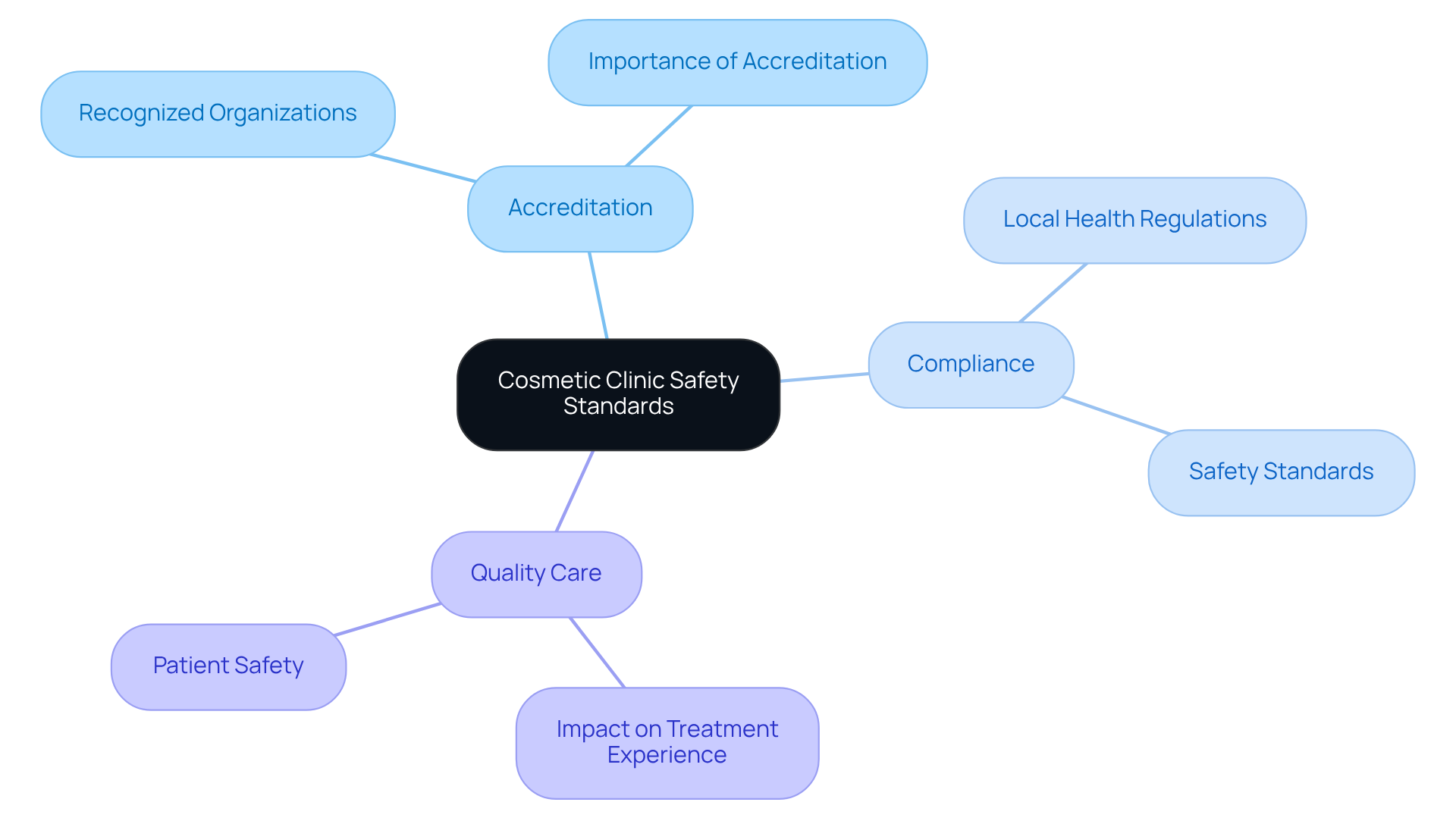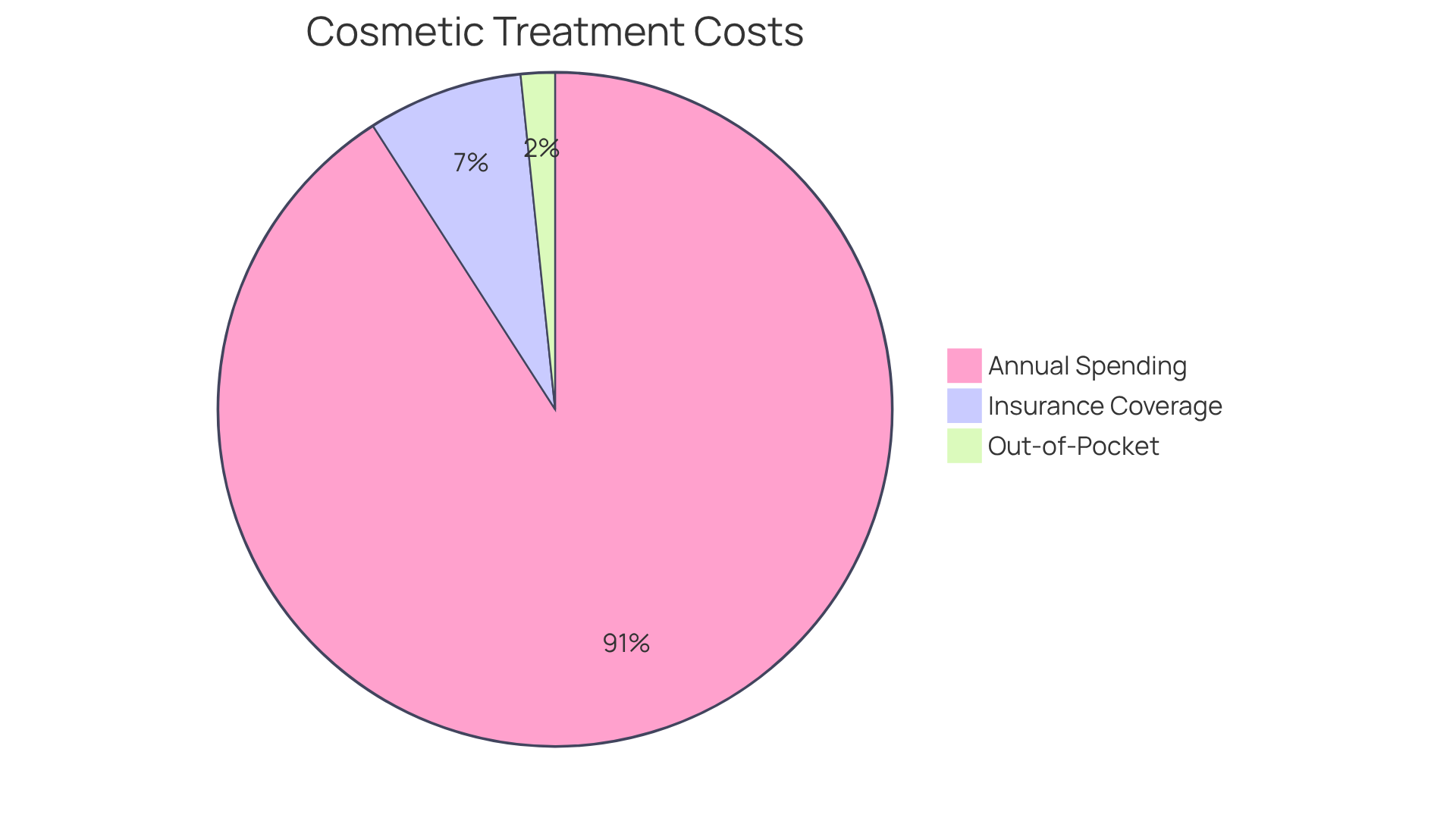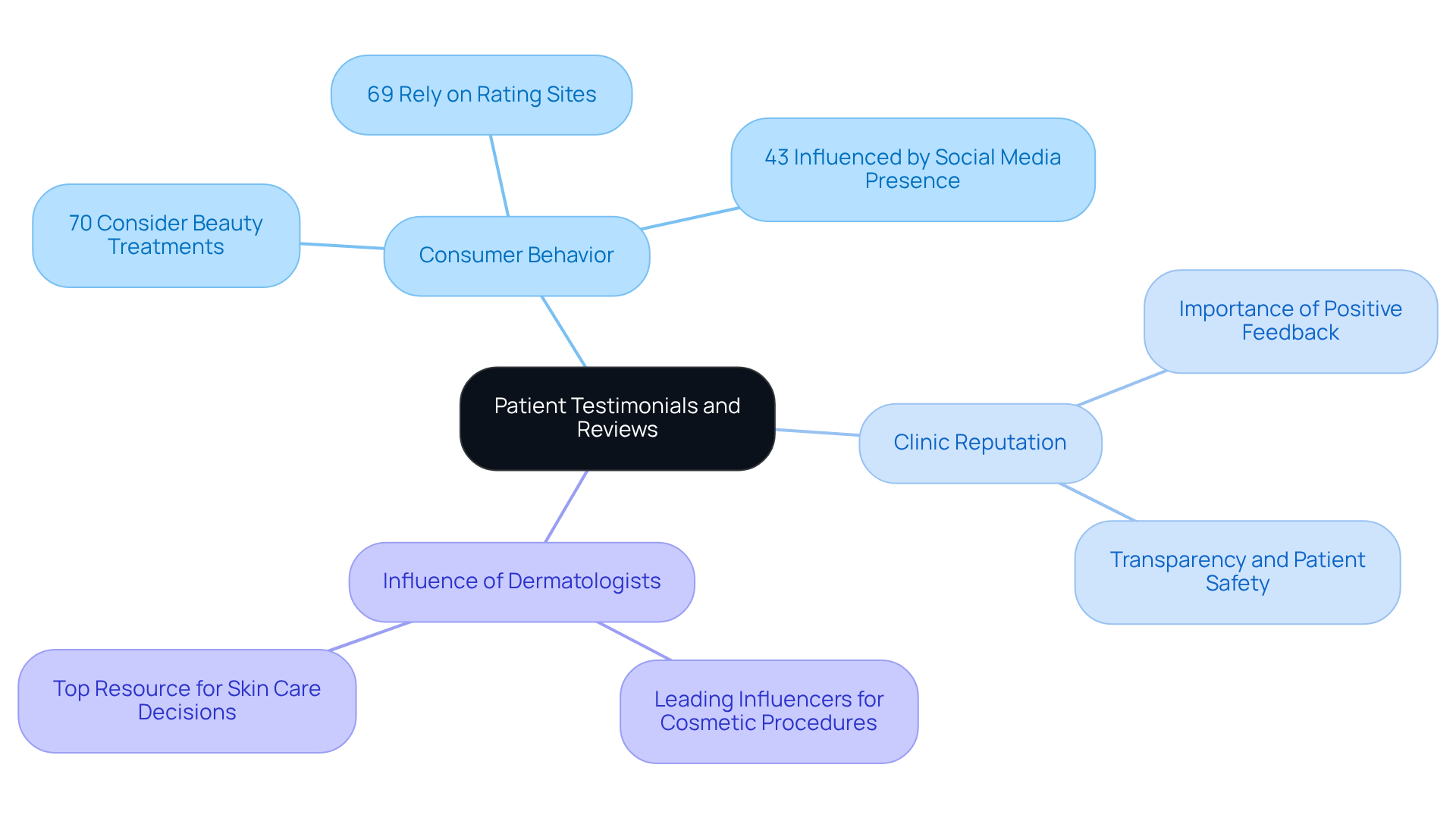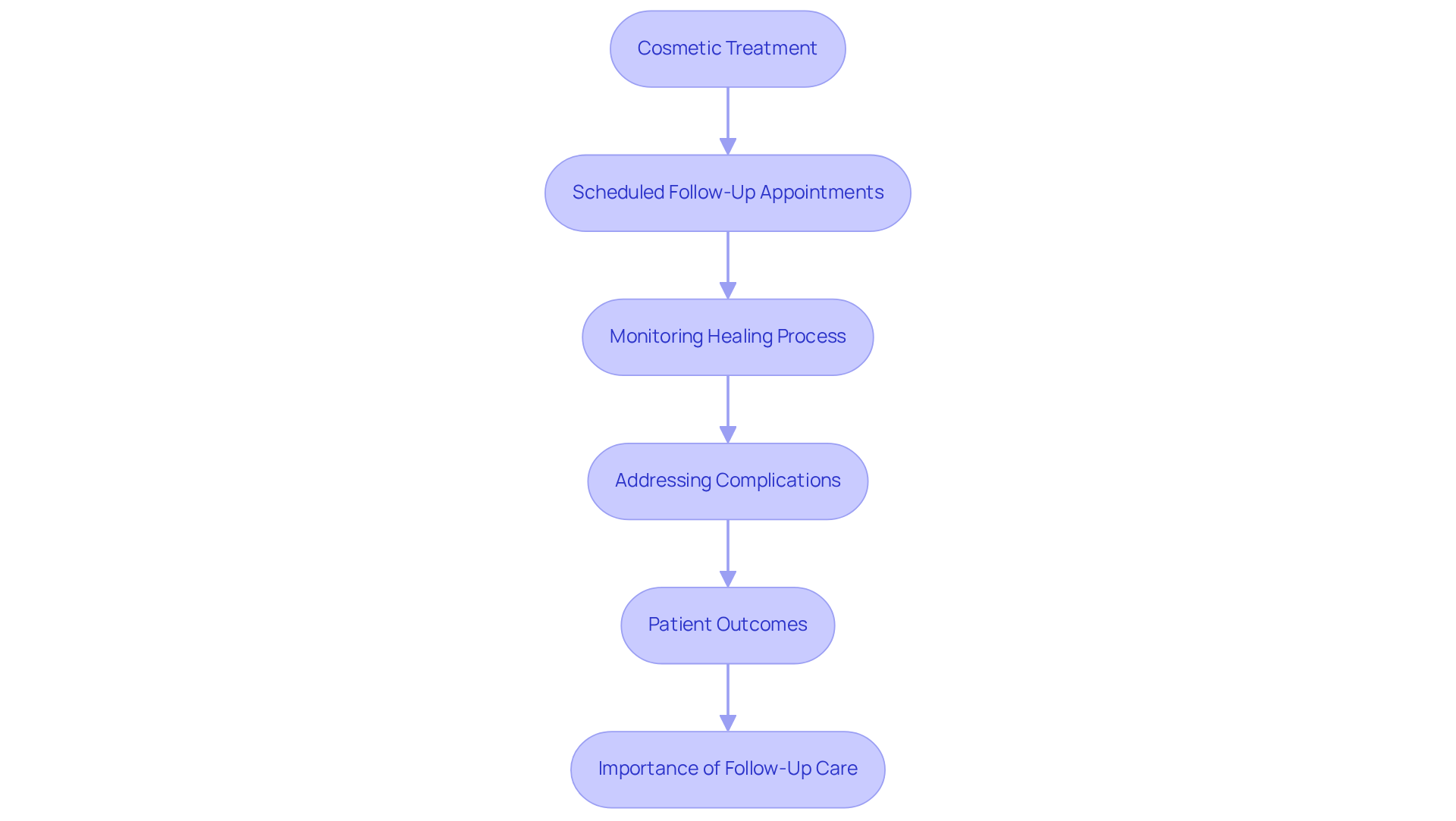10 Key Factors to Evaluate Cosmetic Clinics for Your Needs

Overview
Choosing the right cosmetic clinic is crucial for achieving your desired results. When evaluating options, consider five key factors:
- Qualifications
- Accreditation
- Procedure options
- Costs
- Post-operative care
First and foremost, ensure that the surgeons are board-certified and that the facilities are accredited. This guarantees that you are in capable hands, receiving care that meets industry standards. Additionally, a diverse range of treatment offerings allows you to select the procedure that best suits your needs, ensuring a tailored approach to your cosmetic goals.
Cost transparency is another vital aspect. Understanding the pricing structure upfront helps you avoid unexpected expenses and allows for better financial planning. Finally, robust post-operative care is essential for a smooth recovery and optimal results. Clinics that prioritize follow-up care demonstrate their commitment to patient satisfaction and safety.
By focusing on these factors, you can make informed decisions about your cosmetic procedures. Take the time to research and evaluate your options thoroughly, ensuring that your choice aligns with your expectations and needs.
Introduction
Navigating the landscape of cosmetic clinics can be overwhelming, given the multitude of options and the substantial investments involved. As individuals strive to enhance their appearance, grasping the key factors that influence the quality of care is essential. This article explores ten critical elements to consider when evaluating cosmetic clinics, equipping readers with the insights necessary for making informed decisions.
How can you ensure that the clinic you choose not only aligns with your aesthetic goals but also prioritizes safety and expertise?
What Are the Qualifications and Experience of the Cosmetic Surgeons?
When considering cosmetic clinics, it’s crucial to inquire about the qualifications and experience of their surgeons. Board certification in plastic or cosmetic surgery serves as a vital indicator of a surgeon's rigorous training and commitment to high standards of practice. Only those who have completed a minimum of five years of specialized training and passed extensive examinations can claim this certification, setting them apart from practitioners lacking formal training. Notably, around 15% of plastic surgeons fail the written examination, and about 20% fail the oral test. This statistic underscores the importance of selecting a board-certified surgeon in cosmetic clinics.
Additionally, evaluate the surgeon's years of experience and their specific expertise in the procedures you are considering. Surgeons who concentrate on particular techniques or areas of the body often achieve superior outcomes due to their focused skill set. It’s also wise to request before-and-after photos of previous patients to assess the quality of their work and ensure that their aesthetic aligns with your expectations. As Dr. Josef Hadeed, MD, FACS, advises, "Please do your homework and find out if your surgeon is a board-certified plastic surgeon."
Furthermore, be vigilant about the trend where non-plastic surgeons may claim to be practicing in cosmetic clinics. This highlights the necessity of verifying credentials to ensure you receive the highest standard of care.

Is the Cosmetic Clinic Accredited and Compliant with Safety Standards?
When selecting cosmetic clinics, it’s crucial to ensure they hold accreditation from a recognized organization, such as the Australian Commission on Safety and Quality in Health Care. This accreditation signifies that the facility meets stringent safety and quality standards, significantly reducing the risk of complications during and after treatments. Moreover, it’s essential to verify that the facility complies with local health regulations and maintains a clean, safe environment for all procedures.
By prioritizing accredited cosmetic clinics, you not only safeguard your health but also enhance your overall treatment experience. Remember, cosmetic clinics that are well-accredited are more likely to provide the high-quality care you deserve. Take the time to research and choose wisely—your well-being depends on it.

What Are the Risks and Complications Associated with the Procedures?
Every beauty treatment carries inherent risks, such as infection, scarring, and complications from anesthesia. However, SQT Bio-Microneedling, which utilizes Spongilla spicules, offers a revolutionary alternative that significantly mitigates these risks. Unlike traditional microneedling, which creates around 30,000 micro channels, SQT generates an impressive 3-5 million micro channels in just five minutes. This process not only enhances collagen production but also rejuvenates the skin while minimizing downtime.
The Spongilla spicules are rich in vital nutrients and minerals that stimulate collagen and elastin synthesis, promoting healthier skin. It is essential to engage in an open discussion with your surgeon about these risks before proceeding. Ask about the specific complications associated with the procedure you are considering and how the facility manages these risks. Understanding these factors will help you weigh the benefits against potential downsides.
Notably, SQT therapy has no side effects and is suitable for all skin types, making it a safer option compared to chemical peels and traditional lasers. While flaking or peeling may occur on days 3-5 post-treatment, depending on individual skin conditions, this is a normal part of the regeneration process. Embrace the opportunity to enhance your skin's health and appearance with SQT Bio-Microneedling.

What Specific Cosmetic Procedures Does the Clinic Offer?
Prominent cosmetic clinics offer a diverse array of treatments, catering to both surgical and non-surgical preferences. Surgical options typically encompass facelifts, breast augmentations, and tummy tucks, while non-surgical treatments include popular choices like Botox and dermal fillers. When evaluating cosmetic clinics, it’s crucial to inquire about the specific services they offer and their associated success rates. For instance, in 2023, breast enhancement surgeries reached 249,560, reflecting an 11.2% increase from 2019, with women aged 18-34 accounting for 38.8% of these procedures. This statistic highlights a robust demand for this service. Similarly, facelifts saw 96,061 procedures, marking an impressive 81.5% rise over the same period, with women comprising 93% of these surgeries. Such statistics underscore the effectiveness and popularity of these treatments among patients.
Cosmetic clinics that offer a comprehensive range of services are often better equipped to meet your unique aesthetic goals. This variety not only allows for tailored treatment plans but also enhances the likelihood of achieving desired outcomes. For example, the increase in breast lift operations, which totaled 147,611 in 2023—a 65% rise from 2019—demonstrates a growing interest in improving breast aesthetics, particularly among women aged 35-50.
Moreover, understanding the success rates of different methods can provide valuable insights into the performance of cosmetic clinics. The rising number of rhinoplasty operations, which reached 43,864 in 2023, indicates a consistent demand and suggests a positive perception of the outcomes delivered by professionals. Additionally, the increasing demand for post-weight-loss treatments due to GLP-1 medications highlights current trends in the aesthetic surgery market. By evaluating these factors, including the importance of preoperative discussions to ensure individuals feel acknowledged and valued, you can make a more informed choice when selecting a beauty facility that aligns with your needs and expectations.

What Are the Costs and Payment Options for the Procedures?
The cost of cosmetic treatments at cosmetic clinics varies significantly based on the complexity of the procedure and the facility's location. It's essential to request a detailed cost breakdown, including additional fees for anesthesia, facility usage, and follow-up care. In Australia, the average expense for surgeries like gastric sleeve and gastric bypass hovers around $20,000, with many individuals relying on private health insurance to cover approximately 82% of these costs.
To enhance accessibility, numerous cosmetic clinics provide financing options or payment plans. This strategy enables patients to manage expenses effectively, allowing them to pursue desired treatments without undue financial burden. For instance, Australians collectively spend over $1 billion annually on non-surgical aesthetic procedures at cosmetic clinics, often utilizing financing options to facilitate their choices.
Understanding all financial aspects before committing to a treatment is crucial. Patients should inquire about:
- Interest rates
- Repayment terms
- Any hidden fees tied to financing options
By doing so, individuals can make informed decisions that align with their financial capabilities while prioritizing their aesthetic aspirations.

What Post-Operative Care and Support Does the Clinic Provide?
When evaluating cosmetic clinics, it’s crucial to ask about the post-operative care and support they provide. This includes follow-up appointments, access to nursing staff, and additional resources for managing recovery. Cosmetic clinics that emphasize post-operative care can effectively identify complications early, ensuring proper healing. Research shows that individuals who follow post-operative care instructions experience significantly better recovery outcomes. Regular follow-up visits, typically scheduled at two and six weeks post-surgery, enable healthcare providers to monitor healing and adjust medications as needed.
Furthermore, support services such as physical therapy and nutritional guidance are vital in the recovery process. Adequate nutrition, particularly sufficient protein intake and hydration, is essential for tissue repair and minimizing complications. Patients who maintain a balanced diet and stay hydrated tend to recover more quickly and face fewer post-surgical issues. As healthcare professionals emphasize, actions taken during recovery can either expedite healing or impede it. Therefore, understanding the full spectrum of post-operative assistance offered by cosmetic clinics is critical for achieving optimal outcomes.

What Do Patient Testimonials and Reviews Say About the Clinic?
Investigating patient testimonials and reviews offers valuable insights into the experiences of individuals who have undergone procedures at a facility. It's essential to seek feedback on unbiased platforms like WebMD, Facebook, and Yelp, in addition to the establishment's own website. Focus on comments regarding the quality of care, staff professionalism, and overall satisfaction with results. A clinic that consistently receives positive feedback is likely to provide a superior experience.
With nearly 70% of consumers considering beauty treatments this year, the influence of online reviews is significant. Approximately 69% of users rely on rating and review sites to guide their choices regarding beauty treatment providers. This reliance underscores the importance of independent evaluations in shaping a healthcare facility's reputation. Furthermore, dermatologists have emerged as the leading influencers in aesthetic procedures, having been recognized as the primary resource for skin care product choices for seven consecutive years. This trend reinforces the confidence individuals place in board-certified professionals.
In Sydney's competitive landscape, a facility's reputation plays a crucial role in the decisions made by those seeking care. Independent reviews act as a vital resource for potential clients, assisting them in navigating their options and making informed choices. As the cosmetic industry evolves, cosmetic clinics are increasingly focusing on transparency and patient safety, especially with the introduction of new registration standards for cosmetic surgery endorsement aimed at enhancing patient safety. Consequently, it is imperative for clinics to cultivate a positive online presence and actively encourage honest feedback from their clients.

What Is the Consultation Process Like at the Cosmetic Clinic?
A comprehensive, patient-centered consultation process is essential for achieving successful surgical outcomes. During your initial visit, the surgeon should:
- Thoroughly discuss your goals.
- Evaluate your medical history.
- Clarify the procedures in detail.
This is not just a formality; it’s a critical step in ensuring that you feel comfortable and well-informed. Addressing any questions or concerns you may have is equally important, as it lays the groundwork for a trusting relationship.
A well-executed consultation process sets the stage for success. It’s your opportunity to gauge the surgeon’s expertise and approach, ensuring they align with your expectations. Remember, feeling at ease and informed is paramount before proceeding with any medical decision. Take the time to engage fully in this process—it’s an investment in your health and peace of mind.

What Are the Expected Results and Recovery Times for the Procedures?
Every cosmetic treatment provided by cosmetic clinics comes with its own set of anticipated outcomes and healing timelines, crucial for individuals to understand. During consultations, discussing realistic outcomes and the expected recovery duration with your surgeon is essential. Recovery times can vary significantly based on several factors, including the specific procedure performed, the individual's overall health, and their commitment to post-operative care.
For instance, minimally invasive techniques like Botox typically allow individuals to return to regular activities within a day. In contrast, more extensive surgeries, such as facelifts, may require several weeks for complete recovery. Recent data indicates that the average recovery time for liposuction is approximately two weeks, while individuals undergoing breast augmentation often resume normal activities within one to two weeks, depending on their unique healing rates.
Case studies demonstrate that following post-operative instructions can greatly influence recovery outcomes. Patients who adhere to prescribed care protocols after rhinoplasty frequently experience reduced swelling and faster recovery times. Furthermore, the new regulations for aesthetic treatments in cosmetic clinics, effective from September 2, 2025, emphasize the importance of informed consent and mental health evaluations prior to receiving therapies. Dr. Susan O'Dwyer, Chair of the Medical Board of Australia, emphasized, "We’re also raising the standards for anyone promoting these practices, making it easier for consumers to make safe and informed choices."
By understanding these timelines and factors, you can better prepare for the physical and mental aspects of your aesthetic journey, ensuring a smoother transition post-procedure.

What Follow-Up Procedures Are in Place After the Cosmetic Treatments?
When considering a beauty center, it’s essential to inquire about their follow-up protocols after your treatment. This includes scheduled appointments aimed at monitoring your healing process and addressing any complications that may arise. A clinic that prioritizes follow-up care not only shows a commitment to patient safety but also enhances overall satisfaction with the treatment. Understanding the timeline for follow-up visits and what to expect during these appointments is vital for ensuring a smooth recovery.
Experts emphasize that effective monitoring can significantly influence surgical outcomes, allowing for timely interventions if issues arise. For instance, a study revealed that 15% of women who underwent non-invasive treatments required medical assistance afterward, underscoring the importance of diligent follow-up care. Furthermore, A/Prof Richard Gallagher highlights that plastic surgeons play a crucial role in addressing negative body image, which can be affected by the results of cosmetic procedures. Thus, a comprehensive follow-up strategy is a hallmark of reputable cosmetic clinics, showcasing their dedication to client well-being and successful outcomes.
The case of Lynsey Wanless, who faced severe complications after receiving anti-wrinkle injections in a non-clinical setting, further illustrates the critical need for proper follow-up care to ensure patient safety. This reinforces the necessity of choosing cosmetic clinics that value thorough post-treatment support.

Conclusion
Choosing the right cosmetic clinic is a pivotal decision that can significantly influence both the outcomes of your procedures and your overall experience. By concentrating on crucial factors such as the qualifications and experience of surgeons, clinic accreditation, safety standards, and post-operative care, you can make informed choices tailored to your unique needs. This article serves as a comprehensive guide to help you navigate the complexities of cosmetic treatments.
Key considerations include:
- The necessity of selecting board-certified surgeons
- Understanding the risks associated with various procedures
- Evaluating the range of services offered by clinics
- Being aware of costs and payment options
- The importance of patient testimonials
Engaging in thorough research and maintaining open conversations during consultations can further enhance your decision-making process.
Ultimately, your journey toward achieving desired aesthetic goals should be approached with diligence and care. By prioritizing safety, expertise, and comprehensive support throughout the entire process—from initial consultation to follow-up care—you can embark on your cosmetic journey with confidence. Emphasizing these key factors not only safeguards your health but also fosters a positive and satisfying experience in the pursuit of beauty.
Frequently Asked Questions
What qualifications should I look for in a cosmetic surgeon?
Look for board certification in plastic or cosmetic surgery, which indicates rigorous training and high standards of practice. Surgeons must complete a minimum of five years of specialized training and pass extensive examinations to obtain this certification.
Why is it important to choose a board-certified surgeon?
Board certification is crucial because it signifies that the surgeon has undergone rigorous training and has met high standards of practice. Approximately 15% of plastic surgeons fail the written examination, and about 20% fail the oral test, highlighting the importance of selecting a qualified surgeon.
How can I assess a surgeon's experience and expertise?
Evaluate the surgeon's years of experience and their specific expertise in the procedures you are considering. Request before-and-after photos of previous patients to assess the quality of their work and ensure their aesthetic aligns with your expectations.
What should I verify about the cosmetic clinic's accreditation?
Ensure the cosmetic clinic is accredited by a recognized organization, such as the Australian Commission on Safety and Quality in Health Care. Accreditation indicates that the facility meets stringent safety and quality standards.
Why is accreditation important for cosmetic clinics?
Accreditation is important because it significantly reduces the risk of complications during and after treatments. It also ensures that the facility complies with local health regulations and maintains a clean, safe environment.
What are the risks associated with cosmetic procedures?
Risks associated with cosmetic procedures can include infection, scarring, and complications from anesthesia. It is essential to discuss these risks with your surgeon before proceeding with any treatment.
What is SQT Bio-Microneedling, and how does it differ from traditional microneedling?
SQT Bio-Microneedling uses Spongilla spicules to create 3-5 million micro channels in just five minutes, significantly enhancing collagen production and rejuvenating the skin while minimizing downtime, unlike traditional microneedling which creates around 30,000 micro channels.
What are the benefits of SQT therapy?
SQT therapy has no side effects, is suitable for all skin types, and promotes healthier skin by stimulating collagen and elastin synthesis. Some flaking or peeling may occur post-treatment, which is a normal part of the regeneration process.
How should I prepare for a discussion about risks with my surgeon?
Engage in an open discussion with your surgeon about the specific risks and complications associated with the procedure you are considering, and inquire how the facility manages these risks. Understanding these factors will help you weigh the benefits against potential downsides.

